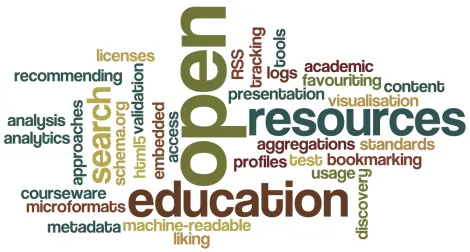
Open Educational Resources: OER Repositories from University of Arkansas
Title courtesy of the 5 R – Framework
Before I started I wanted to do some research into what makes an OER high quality. I found an OER called Open Science that caught my full attention right away. The authors believe that “Openness is a central principle in science and research” and their goal is:
“to make multilingual scientific knowledge openly available, accessible and reusable for everyone, to increase scientific collaborations and sharing of information for the benefits of science and society, and to open the processes of scientific knowledge creation, evaluation and communication to societal actors beyond the traditional scientific community”
After our discussions with Katia on Tuesday, I realize the import and relevance of this lofty goal. I am a sharer, I believe the team at our school is much stronger when we share information; reading the FAQ of the whys and hows of Open Science really created a sense of excitement. And this was just the beginning! But what really drew me to this resource is the How to Account for the Quality of OER? page. It listed 5 main criteria for evaluating OER:
- Content. The content of high-quality open educational resources is reliable.
- Learning and teaching methods. High-quality open educational resources enable the use of diverse ways to learn and teach.
- Usability and accessibility. High-quality open educational resources are as easy to use as possible for everyone and in any situation.
- Findability and sharing. High-quality open educational resources are easy to find, and the users know under which terms and conditions they can share them.
- Lifecycle and adaptability. High-quality open educational resources are maintained and updated on a regular basis. In addition, other open resources and co-development practices are used in the production of the materials.
Each criteria had a list of elements that must be present for it to pass. I.e. to be reliable the content had to be evidence based and (what I was looking for specifically) peer reviewed.
OER Evaluation
When we were in our discussion groups on Tuesday, I mentioned that I rarely find any OERs that I can use as my area is so niche. One of the group members asked if I would use it for professional development. It was the perfect question as that had not occurred to me, I have no idea why. Yes! I certainly would use it for that in my role as an educator and now administrator.
It was with this mindset, I chose OER Commons as the OER repository to explore.

Below is my assessment based on the criteria from Open Science.
Content: It is advertised as High Quality, as seen in this screenshot, below; however, I had to do quite a bit of digging to find any support for that claim. What I finally found was that it does not have a peer-review system. Digging and searching deep into the site, I did come across some “Resource Quality Guidelines” that put the onus on the contributor to make sure the information is up to date and accurate. The site also direct contributors to quality rubric published by Achieve.org as well as a Evaluation Tool from the same publisher. OER Commons also has learning modules available for participants which includes OER Quality Evaluation. While it seems that the site does not act as a gatekeeper, it provides many helpful resources for creating or evaluating OER quality.

Learning and Teaching Methods: I am actually impressed with the content variety available. Content can be searched by material type. I inserted a screenshot as there are too many to mention and it illustrates the variety available. Interactive activities are also included.
A convenient link leads to definitions of each type of activity.
Usability and Accessibility: I took some time to jump into a few resources and they all meet Open Science’s elements in this criteria. Some of those being accessible off-line, Instructions for use, and adapted for the needs of the target group. This assignment is an example of one that I explored. It contains a convenient link to enable to user to share modification and improvements to the assignment.
Findability and Sharing: I believe that the resources also meet the elements to fulfill this criteria. Examples include a description for what kind of use situations they were originally prepared, the resources and their metadata bear the marking of an open access licence, they describe how they can be linked to existing study modules or curricula. This is illustrated in the picture below. The Share icon is circled in red.

Lifecycle and adaptability: As I mentioned above some of the resources have a convenient link that allows the user to modify the resource, others, like this Salmon Life Cycle, has a Remix link that allows you to well, Remix it!
I did not come across any specific messaging around lifecycle timing, however I am confident it will be mentioned somewhere in the quality content I mentioned above.
Overall, I am extremely impressed with this repository. The Home page has a robust and intuitive search function that allows you to search by key word(s), subject, education level, as well as a selection of American educational standards. If your objective is to make a contribution to the knowledge, a green Add OER tab is easily located at the top of the page. The home page, and subsequent others, is very well designed making navigation easy. It looks professional with a clean modern design. I would definitely recommend this to others. Two thumbs up!! 👍 👍

Hi Crystal,
The 5R framework is a great way to evaluate OERs – thanks for sharing! Based on your criteria and assessment, OER Commons sounds like it has the most potential from the class list. A remix button is incredibly beneficial for educators trying to adapt content for their students’ unique needs. I wish more resources had this option! How relevant to what we have been discussing in class.
Thank you for your detailed reflection! I really enjoyed the framework that you used to evaluate the OERs. I had never come across that framework in any of my studies so far. I am going to take note of it, and add it into my evaluation tool kit.
I do find that the lack of peer-to-peer review of resources is a little disconcerting. While I understand it is on us to evaluate the resources we use in our classroom, this oversight can lead to mis and disinformation being passed off as fact, and used in classrooms. I hypothesize that this is in the spirit of true Open Pedagogy, where everyone is allowed a voice and the ability to share. I do think the link to share modifications and improvements is an attempt to prevent mis and disinformation from being completely overlooked. Great reflection and evaluation!